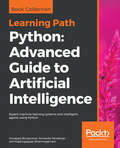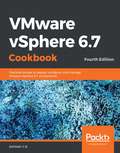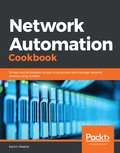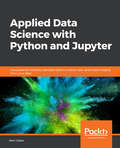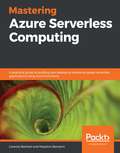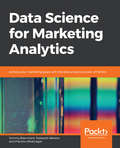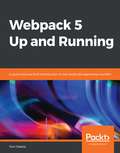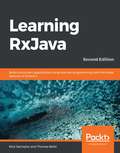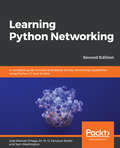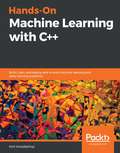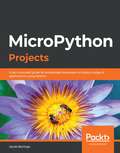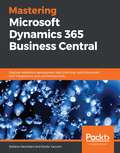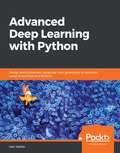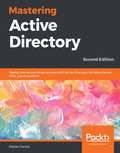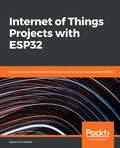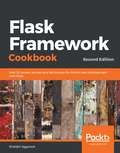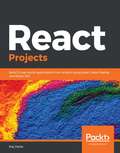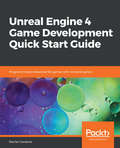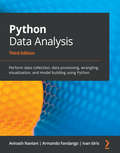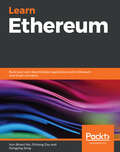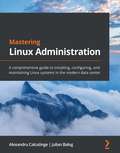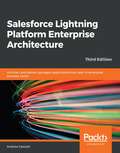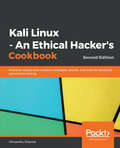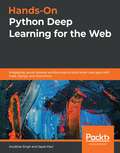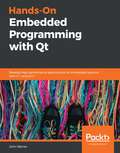- Table View
- List View
Learning Path - Python: Expert Machine Learning Systems And Intelligent Agents Using Python
by Rajalingappaa Shanmugamani Armando Fandango Giuseppe BonaccorsoThis Learning Path is for data scientists, machine learning engineers, artificial intelligence engineers who want to delve into complex machine learning algorithms, calibrate models, and improve the predictions of the trained model. You will encounter the advanced intricacies and complex use cases of deep learning and AI. A basic knowledge of programming in Python and some understanding of machine learning concepts are required to get the best out of this Learning Path.
VMware vSphere 6.7 Cookbook: Practical recipes to deploy, configure, and manage VMware vSphere 6.7 components, 4th Edition
by Abhilash G BProven, actionable ways to install, manage, secure and monitor your vSphere 6.7 environments Key Features Get up to speed with the installation and life cycle management of a vSphere 6.7 environment, using a task-based approach Secure your vSphere environment using SSL Certificates Get introduced to the tools that are used to monitor the performance of the vSphere Environment Book Description VMware vSphere is the most comprehensive core suite of SDDC solutions on the market. It helps transform data centers into simplified on-premises private cloud infrastructures. This edition of the book focuses on the latest version, vSphere 6.7. The books starts with chapters covering the greenfield deployment of vSphere 6.7 components and the upgrade of existing vSphere components to 6.7. You will then learn how to configure storage and network access for a vSphere environment. Get to grips with optimizing your vSphere environment for resource distribution and utilization using features such as DRS and DPM, along with enabling high availability for vSphere components using vSphere HA, VMware FT, and VCHA. Then, you will learn how to facilitate large-scale deployment of stateless/stateful ESXi hosts using Auto Deploy. Finally, you will explore how to upgrade/patch a vSphere environment using vSphere Update Manager, secure it using SSL certificates, and then monitor its performance with tools such as vSphere Performance Charts and esxtop. By the end of this book, you'll be well versed in the core functionalities of vSphere 6.7 and be able to effectively deploy, manage, secure, and monitor your environment. What you will learn Deploy a new vSphere 6.7 environment or upgrade an existing vSphere environment to version 6.7 Learn how to configure and manage storage and network access for a vSphere environment Enable high availability for Hosts, VMs and vCenter Server Optimize your vSphere environment for resource distribution/utilization Patch or upgrade a vSphere environment using vSphere Update Manager Secure vSphere infrastructure components using SSL certificates Effectively monitor the performance of your vSphere environment Who this book is for If you are a systems administrator, support engineer, or anyone who wants to learn how to install, configure, and manage a vSphere environment in a quick, hands-on manner, then this book is for you. Consultants and infrastructure architects who wish to design and deploy vSphere 6.7 environments will also find this book helpful.
Network Automation Cookbook: Proven and actionable recipes to automate and manage network devices using Ansible
by Karim OkashaTake your network automation skills to the next level with practical recipes on managing network devices from a variety of vendors like Cisco, Juniper, and Arista Key Features Use Ansible to automate network infrastructure with the help of step-by-step instructions Implement network automation best practices to save cost, avoid critical errors, and reduce downtime Deliver a robust automation framework by integrating Ansible with NAPALM, NetBox, and Batfish Book Description Network Automation Cookbook is designed to help system administrators, network engineers, and infrastructure automation engineers to centrally manage switches, routers, and other devices in their organization's network. This book will help you gain hands-on experience in automating enterprise networks and take you through core network automation techniques using the latest version of Ansible and Python. With the help of practical recipes, you'll learn how to build a network infrastructure that can be easily managed and updated as it scales through a large number of devices. You'll also cover topics related to security automation and get to grips with essential techniques to maintain network robustness. As you make progress, the book will show you how to automate networks on public cloud providers such as AWS, Google Cloud Platform, and Azure. Finally, you will get up and running with Ansible 2.9 and discover troubleshooting techniques and network automation best practices. By the end of this book, you'll be able to use Ansible to automate modern network devices and integrate third-party tools such as NAPALM, NetBox, and Batfish easily to build robust network automation solutions. What you will learn Understand the various components of Ansible Automate network resources in AWS, GCP, and Azure cloud solutions Use IaC concepts to design and build network solutions Automate network devices such as Cisco, Juniper, Arista, and F5 Use NetBox to build network inventory and integrate it with Ansible Validate networks using Ansible and Batfish Who this book is for This Ansible network automation book is for network and DevOps engineers interested in automating complex network tasks. Prior understanding of networking and basic Linux knowledge is required.
Applied Data Science with Python and Jupyter: Use powerful industry-standard tools to unlock new, actionable insights from your data
by Alex GaleaBecome the master player of data exploration by creating reproducible data processing pipelines, visualizations, and prediction models for your applications.Key FeaturesGet up and running with the Jupyter ecosystem and some example datasetsLearn about key machine learning concepts such as SVM, KNN classifiers, and Random ForestsDiscover how you can use web scraping to gather and parse your own bespoke datasetsBook DescriptionGetting started with data science doesn't have to be an uphill battle. Applied Data Science with Python and Jupyter is a step-by-step guide ideal for beginners who know a little Python and are looking for a quick, fast-paced introduction to these concepts. In this book, you'll learn every aspect of the standard data workflow process, including collecting, cleaning, investigating, visualizing, and modeling data. You'll start with the basics of Jupyter, which will be the backbone of the book. After familiarizing ourselves with its standard features, you'll look at an example of it in practice with our first analysis. In the next lesson, you dive right into predictive analytics, where multiple classification algorithms are implemented. Finally, the book ends by looking at data collection techniques. You'll see how web data can be acquired with scraping techniques and via APIs, and then briefly explore interactive visualizations.What you will learnGet up and running with the Jupyter ecosystemIdentify potential areas of investigation and perform exploratory data analysisPlan a machine learning classification strategy and train classification modelsUse validation curves and dimensionality reduction to tune and enhance your modelsScrape tabular data from web pages and transform it into Pandas DataFramesCreate interactive, web-friendly visualizations to clearly communicate your findingsWho this book is forApplied Data Science with Python and Jupyter is ideal for professionals with a variety of job descriptions across a large range of industries, given the rising popularity and accessibility of data science. You'll need some prior experience with Python, with any prior work with libraries such as Pandas, Matplotlib, and Pandas providing you a useful head start.
Mastering Azure Serverless Computing: A practical guide to building and deploying enterprise-grade serverless applications using Azure Functions
by Lorenzo Barbieri Massimo BonanniBecome an expert in implementing Azure Functions to work seamlessly with your serverless applications Key Features Develop scalable, robust multi-tier apps without worrying about infrastructure needs Deploy and manage cost-effective and highly available serverless apps using Azure Functions Accelerate enterprise-level application development by seamlessly integrating different cloud services with Azure Functions Book Description Application development has evolved from traditional monolithic app development to using serverless options and microservices. This book is designed to guide you through using Microsoft's Azure Functions to process data, integrate systems, and build simple APIs and microservices. You will discover how to apply serverless computing to speed up deployment and reduce downtime. You'll also explore Azure Functions, including its core functionalities and essential tools, along with understanding how to debug and even customize Azure Functions. In addition to this, the book will take you through how you can effectively implement DevOps and automation in your working environment. Toward the concluding chapters, you'll cover some quick tips, troubleshooting techniques, and real-world serverless use cases that will help you make the most of serverless computing. By the end of this book, you will have gained the skills you need to develop and deliver cost-effective Azure serverless solutions. What you will learn Create and deploy advanced Azure Functions Learn to extend the runtime of Azure Functions Orchestrate your logic through code or a visual workflow Add caching, security, routing, and filtering to your APIs Use serverless technologies in real-world scenarios Understand how to apply DevOps and automation to your working environment Who this book is for This book is designed for cloud administrators, architects, and developers interested in building scalable systems and deploying serverless applications with Azure Functions. Prior knowledge of core Microsoft Azure services and Azure Functions is necessary to understand the topics covered in this book.
Marketing Analytics with Python: Achieve your marketing goals with the data analytics power of Python
by Tommy Blanchard Pranshu Bhatnagar Debasish BeheraMarketing Analytics with Python is designed for developers and marketing analysts looking to bring new and more sophisticated tools to their marketing analytics efforts. It'll help you to have prior experience of coding in Python and knowledge of high school level mathematics. Some experience with databases, Excel, statistics, or Tableau is useful, but is not necessary.
Webpack 5 Up and Running: A quick and practical introduction to the JavaScript application bundler
by Tom OwensImprove the development workflow and manage utilities with the latest Webpack and Babel features Key Features A beginner's guide to understanding application bundling and Webpack project structure Leverage Webpack's modular builds to optimize the performance of your web apps Discover how Webpack facilitates package bundling and understand its integration with Angular and Vue.js Book Description Webpack has emerged as one of the most popular module bundlers used in web development projects, and serves as one of the most advanced web development build tools. This quick reference begins with an introduction to Webpack and teaches you how to use it for initializing dependency management in your web projects. Starting with code splitting and transpiling, you will be taught about dependency graphs and how to configure them to achieve improved functionality and uncover hidden features. You'll also learn the difference between configuration files and options, and how Node.js plays a role in their creation and management. As you advance, you will delve into frameworks and unsupported code, which can be processed using loaders. Moving on, you'll be well on your way to performing application bundling efficiently, and will be introduced to the art of custom loader creation and plugin development. By the end of this Webpack book, you'll have gained a basic understanding of deployment, live coding, and even hot module replacement, and you'll be able to incorporate application bundling in your web project efficiently. What you will learn Get to grips with Webpack bundle configuration and set options Optimize your JavaScript projects by using code-splitting techniques Efficiently handle dependencies in complex web apps Break down complex problems into simple ones using advanced debugging procedures Master version migration and deployment hurdles Effectively deploy the Webpack application using Babel Who this book is for The book is for web developers looking to get started with dependency management in their web project by learning Webpack. Working knowledge of JavaScript is assumed.
Learning RxJava: Build concurrent applications using reactive programming with the latest features of RxJava 3, 2nd Edition
by Thomas Nield Nick SamoylovUpdated with the latest Maven coordinates, Java programming features, and API changes, this book is your guide to solving problems in writing asynchronous and event-based programs Key Features Explore a variety of tools and techniques used to solve problems in implementing concurrency and parallelization Learn about core operators in RxJava that enable you to express your code logic productively Apply RxJava with Kotlin to create responsive Android apps with better user experience Book Description RxJava is not just a popular library for building asynchronous and event-based applications; it also enables you to create a cleaner and more readable code base. In this book, you'll cover the core fundamentals of reactive programming and learn how to design and implement reactive libraries and applications. Learning RxJava will help you understand how reactive programming works and guide you in writing your first example in reactive code. You'll get to grips with the workings of Observable and Subscriber, and see how they are used in different contexts using real-world use cases. The book will also take you through multicasting and caching to help prevent redundant work with multiple Observers. You'll then learn how to create your own RxJava operators by reusing reactive logic. As you advance, you'll explore effective tools and libraries to test and debug RxJava code. Finally, you'll delve into RxAndroid extensions and use Kotlin features to streamline your Android apps. By the end of this book, you'll become proficient in writing reactive code in Java and Kotlin to build concurrent applications, including Android applications. What you will learn Discover different ways to create Observables, Observers, and Subscribers Multicast in order to push data to multiple destinations and cache and replay them Express RxJava idiomatically with the help of Kotlin features such as extension functions and data classes Become familiar with various operators available in RxJava to perform common transformations and tasks Explore RxJava's reactive types, including Flowable, Single, Maybe, and Completable Demystify Observables and how they express data and events as sequences Who this book is for This book is for Java developers who want to leverage reactive programming to develop more resilient and concurrent applications. If you're an RxJava user looking to get to grips with the latest features and updates in RxJava 3, this book is for you. Fundamental knowledge of core Java features and object-oriented programming will assist you in understanding the key concepts covered in this book.
Learning Python Networking: A complete guide to build and deploy strong networking capabilities using Python 3.7 and Ansible , 2nd Edition
by Sam Washington Jose Manuel Ortega Dr. M. SarkerAchieve improved network programmability and automation by leveraging powerful network programming concepts, algorithms, and tools Key Features Deal with remote network servers using SSH, FTP, SNMP and LDAP protocols. Design multi threaded and event-driven architectures for asynchronous servers programming. Leverage your Python programming skills to build powerful network applications Book Description Network programming has always been a demanding task. With full-featured and well-documented libraries all the way up the stack, Python makes network programming the enjoyable experience it should be. Starting with a walk through of today's major networking protocols, through this book, you'll learn how to employ Python for network programming, how to request and retrieve web resources, and how to extract data in major formats over the web. You will utilize Python for emailing using different protocols, and you'll interact with remote systems and IP and DNS networking. You will cover the connection of networking devices and configuration using Python 3.7, along with cloud-based network management tasks using Python. As the book progresses, socket programming will be covered, followed by how to design servers, and the pros and cons of multithreaded and event-driven architectures. You'll develop practical clientside applications, including web API clients, email clients, SSH, and FTP. These applications will also be implemented through existing web application frameworks. What you will learn Execute Python modules on networking tools Automate tasks regarding the analysis and extraction of information from a network Get to grips with asynchronous programming modules available in Python Get to grips with IP address manipulation modules using Python programming Understand the main frameworks available in Python that are focused on web application Manipulate IP addresses and perform CIDR calculations Who this book is for If you're a Python developer or a system administrator with Python experience and you're looking to take your first steps in network programming, then this book is for you. If you're a network engineer or a network professional aiming to be more productive and efficient in networking programmability and automation then this book would serve as a useful resource. Basic knowledge of Python is assumed.
Hands-On Machine Learning with C++: Build, train, and deploy end-to-end machine learning and deep learning pipelines
by Kirill KolodiazhnyiImplement supervised and unsupervised machine learning algorithms using C++ libraries such as PyTorch C++ API, Caffe2, Shogun, Shark-ML, mlpack, and dlib with the help of real-world examples and datasets Key Features Become familiar with data processing, performance measuring, and model selection using various C++ libraries Implement practical machine learning and deep learning techniques to build smart models Deploy machine learning models to work on mobile and embedded devices Book Description C++ can make your machine learning models run faster and more efficiently. This handy guide will help you learn the fundamentals of machine learning (ML), showing you how to use C++ libraries to get the most out of your data. This book makes machine learning with C++ for beginners easy with its example-based approach, demonstrating how to implement supervised and unsupervised ML algorithms through real-world examples. This book will get you hands-on with tuning and optimizing a model for different use cases, assisting you with model selection and the measurement of performance. You'll cover techniques such as product recommendations, ensemble learning, and anomaly detection using modern C++ libraries such as PyTorch C++ API, Caffe2, Shogun, Shark-ML, mlpack, and dlib. Next, you'll explore neural networks and deep learning using examples such as image classification and sentiment analysis, which will help you solve various problems. Later, you'll learn how to handle production and deployment challenges on mobile and cloud platforms, before discovering how to export and import models using the ONNX format. By the end of this C++ book, you will have real-world machine learning and C++ knowledge, as well as the skills to use C++ to build powerful ML systems. What you will learn Explore how to load and preprocess various data types to suitable C++ data structures Employ key machine learning algorithms with various C++ libraries Understand the grid-search approach to find the best parameters for a machine learning model Implement an algorithm for filtering anomalies in user data using Gaussian distribution Improve collaborative filtering to deal with dynamic user preferences Use C++ libraries and APIs to manage model structures and parameters Implement a C++ program to solve image classification tasks with LeNet architecture Who this book is for You will find this C++ machine learning book useful if you want to get started with machine learning algorithms and techniques using the popular C++ language. As well as being a useful first course in machine learning with C++, this book will also appeal to data analysts, data scientists, and machine learning developers who are looking to implement different machine learning models in production using varied datasets and examples. Working knowledge of the C++ programming language is mandatory to get started with this book.
MicroPython Projects: A do-it-yourself guide for embedded developers to build a range of applications using Python
by Jacob BeningoExplore MicroPython through a series of hands-on projects and learn to design and build your own embedded systems using the MicroPython Pyboard, ESP32, the STM32 IoT Discovery kit, and the OpenMV camera module. Key Features Delve into MicroPython Kernel and learn to make modifications that will enhance your embedded applications Design and implement drivers to interact with a variety of sensors and devices Build low-cost projects such as DIY automation and object detection with machine learning Book Description With the increasing complexity of embedded systems seen over the past few years, developers are looking for ways to manage them easily by solving problems without spending a lot of time on finding supported peripherals. MicroPython is an efficient and lean implementation of the Python 3 programming language, which is optimized to run on microcontrollers. MicroPython Projects will guide you in building and managing your embedded systems with ease. This book is a comprehensive project-based guide that will help you build a wide range of projects and give you the confidence to design complex projects spanning new areas of technology such as electronic applications, automation devices, and IoT applications. While building seven engaging projects, you'll learn how to enable devices to communicate with each other, access and control devices over a TCP/IP socket, and store and retrieve data. The complexity will increase progressively as you work on different projects, covering areas such as driver design, sensor interfacing, and MicroPython kernel customization. By the end of this MicroPython book, you'll be able to develop industry-standard embedded systems and keep up with the evolution of the Internet of Things. What you will learn Develop embedded systems using MicroPython Build a custom debugging tool to visualize sensor data in real-time Detect objects using machine learning and MicroPython Discover how to minimize project costs and reduce development time Get to grips with gesture operations and parsing gesture data Learn how to customize and deploy the MicroPython kernel Explore the techniques for scheduling application tasks and activities Who this book is for If you are an embedded developer or hobbyist looking to build interesting projects using MicroPython, this book is for you. A basic understanding of electronics and Python is required while some MicroPython experience will be helpful.
Mastering Microsoft Dynamics 365 Business Central: Discover extension development best practices, build advanced ERP integrations, and use DevOps tools
by Stefano Demiliani Duilio TacconiDevelop customized business management solutions with the latest features of Microsoft Dynamics 365 Business Central Key Features Learn Dynamics 365 Business Central, the next generation of Dynamics NAV Explore advanced topics for handling complex integrations such as using APIs, OData, and Azure Functions Discover best practices for developing SaaS extensions and moving existing solutions to the cloud Book Description Dynamics 365 Business Central is an all-in-one business management solution, which is easy to adopt and helps you make smarter business decisions. This book is a comprehensive guide to developing solutions with Microsoft ERP (in the cloud and also on-premises). It covers all aspects of developing extensions, right from preparing a sandbox environment to deploying a complete solution. The book starts by introducing you to the Dynamics 365 Business Central platform and the new Modern Development Environment. You'll then explore the sandbox concept, and see how to create sandboxes for development. As you advance, you'll be able to build a complete advanced solution for Dynamics 365 Business Central with AL language and Visual Studio Code. You'll then learn how to debug and deploy the extension and write automatic testing. The book will also take you through advanced topics like integration (with Azure Functions, web services, and APIs), DevOps and CI/CD techniques, and machine learning. You'll discover how Dynamics 365 Business Central can be used with Office 365 apps. Finally, you'll analyze different ways to move existing solutions to the new development model based on extensions. By the end of this book, you'll be able to develop highly customized solutions that meet the requirements of modern businesses using Dynamics 365 Business Central. What you will learn Create a sandbox environment with Dynamics 365 Business Central Handle source control management when developing solutions Explore extension testing, debugging, and deployment Create real-world business processes using Business Central and different Azure services Integrate Business Central with external applications Apply DevOps and CI/CD to development projects Move existing solutions to the new extension-based architecture Who this book is for If you're a new developer looking to get started with Dynamics 365 Business Central, this book is for you. This book will also help experienced professionals enhance their knowledge and understanding of Dynamics 365 Business Central.
Advanced Deep Learning with Python: Design and implement advanced next-generation AI solutions using TensorFlow and PyTorch
by Ivan VasilevGain expertise in advanced deep learning domains such as neural networks, meta-learning, graph neural networks, and memory augmented neural networks using the Python ecosystem Key Features Get to grips with building faster and more robust deep learning architectures Investigate and train convolutional neural network (CNN) models with GPU-accelerated libraries such as TensorFlow and PyTorch Apply deep neural networks (DNNs) to computer vision problems, NLP, and GANs Book Description In order to build robust deep learning systems, you'll need to understand everything from how neural networks work to training CNN models. In this book, you'll discover newly developed deep learning models, methodologies used in the domain, and their implementation based on areas of application. You'll start by understanding the building blocks and the math behind neural networks, and then move on to CNNs and their advanced applications in computer vision. You'll also learn to apply the most popular CNN architectures in object detection and image segmentation. Further on, you'll focus on variational autoencoders and GANs. You'll then use neural networks to extract sophisticated vector representations of words, before going on to cover various types of recurrent networks, such as LSTM and GRU. You'll even explore the attention mechanism to process sequential data without the help of recurrent neural networks (RNNs). Later, you'll use graph neural networks for processing structured data, along with covering meta-learning, which allows you to train neural networks with fewer training samples. Finally, you'll understand how to apply deep learning to autonomous vehicles. By the end of this book, you'll have mastered key deep learning concepts and the different applications of deep learning models in the real world. What you will learn Cover advanced and state-of-the-art neural network architectures Understand the theory and math behind neural networks Train DNNs and apply them to modern deep learning problems Use CNNs for object detection and image segmentation Implement generative adversarial networks (GANs) and variational autoencoders to generate new images Solve natural language processing (NLP) tasks, such as machine translation, using sequence-to-sequence models Understand DL techniques, such as meta-learning and graph neural networks Who this book is for This book is for data scientists, deep learning engineers and researchers, and AI developers who want to further their knowledge of deep learning and build innovative and unique deep learning projects. Anyone looking to get to grips with advanced use cases and methodologies adopted in the deep learning domain using real-world examples will also find this book useful. Basic understanding of deep learning concepts and working knowledge of the Python programming language is assumed.
Mastering Active Directory: Deploy and secure infrastructures with Active Directory, Windows Server 2016, and PowerShell, 2nd Edition
by Dishan FrancisBecome an expert at managing enterprise identity infrastructure by leveraging Active Directory Key Features Explore the new features in Active Directory Domain Service Manage your Active Directory services for Windows Server 2016 effectively Automate administrative tasks in Active Directory using PowerShell Core 6.x Book Description Active Directory (AD) is a centralized and standardized system that automates networked management of user data, security, and distributed resources and enables inter-operation with other directories. This book will first help you brush up on the AD architecture and fundamentals, before guiding you through core components, such as sites, trust relationships, objects, and attributes. You will then explore AD schemas, LDAP, RMS, and security best practices to understand objects and components and how they can be used effectively. Next, the book will provide extensive coverage of AD Domain Services and Federation Services for Windows Server 2016, and help you explore their new features. Furthermore, you will learn to manage your identity infrastructure for a hybrid cloud setup. All this will help you design, plan, deploy, manage operations, and troubleshoot your enterprise identity infrastructure in a secure and effective manner. You'll later discover Azure AD Module, and learn to automate administrative tasks using PowerShell cmdlets. All along, this updated second edition will cover content based on the latest version of Active Directory, PowerShell 5.1 and LDAP. By the end of this book, you'll be well versed with best practices and troubleshooting techniques for improving security and performance in identity infrastructures. What you will learn Design your Hybrid AD environment by evaluating business and technology requirements Protect sensitive data in a hybrid environment using Azure Information Protection Explore advanced functionalities of the schema Learn about Flexible Single Master Operation (FSMO) roles and their placement Install and migrate Active Directory from older versions to Active Directory 2016 Control users, groups, and devices effectively Design your OU structure in the most effective way Integrate Azure AD with Active Directory Domain Services for a hybrid setup Who this book is for If you are an Active Directory administrator, system administrator, or network professional who has basic knowledge of Active Directory and is looking to become an expert in this topic, this book is for you.
Internet of Things Projects with ESP32: Build exciting and powerful IoT projects using the all-new Espressif ESP32
by Agus KurniawanCreate and program Internet of Things projects using the Espressif ESP32. Key Features Getting to know the all new powerful EPS32 boards and build interesting Internet of Things projects Configure your ESP32 to the cloud technologies and explore the networkable modules that will be utilised in your IoT projects A step-by-step guide that teaches you the basic to advanced IoT concepts with ESP32 Book Description ESP32 is a low-cost MCU with integrated Wi-Fi and BLE. Various modules and development boards-based on ESP32 are available for building IoT applications easily. Wi-Fi and BLE are a common network stack in the Internet of Things application. These network modules can leverage your business and projects needs for cost-effective benefits. This book will serve as a fundamental guide for developing an ESP32 program. We will start with GPIO programming involving some sensor devices. Then we will study ESP32 development by building a number of IoT projects, such as weather stations, sensor loggers, smart homes, Wi-Fi cams and Wi-Fi wardriving. Lastly, we will enable ESP32 boards to execute interactions with mobile applications and cloud servers such as AWS. By the end of this book, you will be up and running with various IoT project-based ESP32 chip. What you will learn Understand how to build a sensor monitoring logger Create a weather station to sense temperature and humidity using ESP32 Build your own W-iFi wardriving with ESP32. Use BLE to make interactions between ESP32 and Android Understand how to create connections to interact between ESP32 and mobile applications Learn how to interact between ESP32 boards and cloud servers Build an IoT Application-based ESP32 board Who this book is for This book is for those who want to build a powerful and inexpensive IoT projects using the ESP32.Also for those who are new to IoT, or those who already have experience with other platforms such as Arduino, ESP8266, and Raspberry Pi.
Flask Framework Cookbook: Over 80 proven recipes and techniques for Python web development with Flask, 2nd Edition
by Shalabh AggarwalBuild state-of-the-art web applications quickly and efficiently using Flask and related technologies with Python 3 Key Features Updated to Flask 1.0.3 and Python 3.7 with coverage of Microservices Get the most out of the powerful Flask framework and maintain the flexibility of your design choices Write cleaner and maintainable code with the help of sample apps Book Description Flask, the lightweight Python web framework, is popular due to its powerful modular design that lets you build scalable web apps. With this recipe-based guide, you'll explore modern solutions and best practices for Flask web development. Updated to the latest version of Flask and Python 3, this second edition of Flask Framework Cookbook moves away from some of the old and obsolete libraries and introduces recipes on bleeding edge technologies. You'll discover different ways of using Flask to create, deploy, and manage microservices. This Flask Python book starts by covering the different configurations that a Flask application can make use of, and then helps you work with templates and learn about the ORM and view layers. You'll also be able to write an admin interface and get to grips with debugging and logging errors. Finally, you'll grasp a variety of deployment and post-deployment techniques for platforms such as Apache, Tornado, and Heroku. By the end of this book, you'll have gained all the knowledge you need to write Flask applications in the best possible way and scale them using standard industry practices. What you will learn Explore web application development in Flask, right from installation to post-deployment stages Make use of advanced templating and data modeling techniques Discover effective debugging, logging, and error handling techniques in Flask Integrate Flask with different technologies such as Redis, Sentry, and MongoDB Deploy and package Flask applications with Docker and Kubernetes Design scalable microservice architecture using AWS LambdaContinuous integration and Continuous deployment Who this book is for If you are a web developer who wants to learn more about developing scalable and production-ready applications in Flask, this is the book for you. You'll also find this book useful if you are already aware of Flask's major extensions and want to use them for better application development. Basic Python programming experience along with basic understanding of Flask is assumed.
React Projects: Build 12 real-world applications from scratch using React, React Native, and React 360
by Roy DerksBuild cross-platform applications of varying complexity for the web, mobile, and VR devices using React tooling Key Features Build React applications at scale using effective React patterns and best practices Explore React features such as Hooks, the Context API, and the Suspense API Extend React's integration with React Native for building cross-platform mobile apps and games Book Description Developed by Facebook, React is a popular library for building impressive user interfaces. React extends its capabilities to the mobile platform using the React Native framework and integrates with popular web and mobile tools to build scalable applications. React Projects is your guide to learning React development by using modern development patterns and integrating React with powerful web tools such as GraphQL, Expo, and React 360. You'll start building a real-world project right from the first chapter and get hands on with developing scalable applications as you advance to building more complex projects. Throughout the book, you'll use the latest versions of React and React Native to explore features such as Higher Order Components (HOC), Context, and Hooks on multiple platforms, which will help you build full stack web and mobile applications efficiently. Finally, you'll delve into unit testing with Jest to build test-driven apps. By the end of this React book, you'll have developed the skills necessary to start building scalable React apps across web and mobile platforms. What you will learn Create a wide range of applications using various modern React tools and frameworks Discover how React Hooks modernize state management for React apps Develop progressive web applications using React components Build test-driven React applications using the Jest and Enzyme frameworks Understand full stack development using React, Apollo, and GraphQL Perform server-side rendering using React and React Router Design gestures and animations for a cross-platform game using React Native Who this book is for The book is for JavaScript developers who want to explore React tooling and frameworks for building cross-platform applications. Basic knowledge of web development, ECMAScript, and React will assist with understanding key concepts covered in this book.
Unreal Engine 4 Game Development Quick Start Guide: Programming professional 3D games with Unreal Engine 4
by Rachel CordoneLearn how to use Unreal Engine 4 by building 3D and multiplayer games using BlueprintsKey FeaturesLearn the fundamentals of Unreal Engine such as project templates, Blueprints, and C++Learn to design games; use UMG to create menus and HUDs, and replication to create multiplayer gamesBuild dynamic game elements using Animation Blueprints and Behavior TreesBook DescriptionUnreal Engine is a popular game engine for developers to build high-end 2D and 3D games.This book is a practical guide, starting off by quickly introducing you to the Unreal Engine 4 (UE4) ecosystem. You will learn how to create Blueprints and C++ code to define your game's functionality. You will be familiarized with the core systems of UE4 such as UMG, Animation Blueprints, and Behavior Trees. You will also learn how to use replication to create multiplayer games. By the end of this book, you will have a broad, solid knowledge base to expand upon on your journey with UE4.What you will learnUse project templates to give your game a head startCreate custom Blueprints and C++ classes and extend from Epic's base classesUse UMG to create menus and HUDs for your gameCreate more dynamic characters using Animation BlueprintsLearn how to create complex AI with Behavior TreesUse replication to create multiplayer gamesOptimize, test, and deploy a UE4 projectWho this book is forReaders who already have some game development experience and Unity users who would like to try UE4 will all benefit from this book. Knowledge of basic Object-Oriented Programming topics such as variables, functions, and classes is assumed.
Python Data Analysis: Perform data collection, data processing, wrangling, visualization, and model building using Python, 3rd Edition
by Ivan Idris Armando Fandango Avinash NavlaniUnderstand data analysis pipelines using machine learning algorithms and techniques with this practical guideKey FeaturesPrepare and clean your data to use it for exploratory analysis, data manipulation, and data wranglingDiscover supervised, unsupervised, probabilistic, and Bayesian machine learning methodsGet to grips with graph processing and sentiment analysisBook DescriptionData analysis enables you to generate value from small and big data by discovering new patterns and trends, and Python is one of the most popular tools for analyzing a wide variety of data. With this book, you'll get up and running using Python for data analysis by exploring the different phases and methodologies used in data analysis and learning how to use modern libraries from the Python ecosystem to create efficient data pipelines.Starting with the essential statistical and data analysis fundamentals using Python, you'll perform complex data analysis and modeling, data manipulation, data cleaning, and data visualization using easy-to-follow examples. You'll then understand how to conduct time series analysis and signal processing using ARMA models. As you advance, you'll get to grips with smart processing and data analytics using machine learning algorithms such as regression, classification, Principal Component Analysis (PCA), and clustering. In the concluding chapters, you'll work on real-world examples to analyze textual and image data using natural language processing (NLP) and image analytics techniques, respectively. Finally, the book will demonstrate parallel computing using Dask.By the end of this data analysis book, you'll be equipped with the skills you need to prepare data for analysis and create meaningful data visualizations for forecasting values from data.What you will learnExplore data science and its various process modelsPerform data manipulation using NumPy and pandas for aggregating, cleaning, and handling missing valuesCreate interactive visualizations using Matplotlib, Seaborn, and BokehRetrieve, process, and store data in a wide range of formatsUnderstand data preprocessing and feature engineering using pandas and scikit-learnPerform time series analysis and signal processing using sunspot cycle dataAnalyze textual data and image data to perform advanced analysisGet up to speed with parallel computing using DaskWho this book is forThis book is for data analysts, business analysts, statisticians, and data scientists looking to learn how to use Python for data analysis. Students and academic faculties will also find this book useful for learning and teaching Python data analysis using a hands-on approach. A basic understanding of math and working knowledge of the Python programming language will help you get started with this book.
Learn Ethereum: Build your own decentralized applications with Ethereum and smart contracts
by Xun (Brian) Wu Zhihong Zou Dongying SongExplore the blockchain-based decentralized platform and understand how Ethereum works with Dapps examples Key Features Explore the Ethereum ecosystem and understand the latest research on the platform Build decentralized apps (Dapps) using smart contracts and Ethereum with the help of practical examples Learn to make your decentralized applications fast and highly secure Book Description Ethereum is a blockchain-based, decentralized computing platform that allows running smart contracts. This book provides a basic overview of how Ethereum works, its ecosystem, mining process, and the consensus mechanism. It also demonstrates a step-by-step approach for building decentralized applications. This book begins with the very basics of Blockchain technology. Then it dives deep into the Ethereum architecture, framework and tools in its ecosystem. It also provides you an overview of ongoing research on Ethereum, for example, Layer 1 and 2 scaling solution, Stablecoin, ICO/STO/IEO, etc. Next, it explains Solidity language in detail, and provides step-by-step instructions for designing, developing, testing, deploying, and monitoring decentralized applications. In addition, you'll learn how to use Truffle, Remix, Infura, Metamask, and many other Ethereum technologies. It'll also help you develop your own cryptocurrency by creating ERC20, and ERC721 smart contracts from scratch. Finally, we explain private blockchains, and you learn how to interact with smart contracts through wallets. What you will learn Understand the concepts of blockchain and cryptocurrency Master Ethereum development tools such as Truffle, Remix IDE and Infura Delve into smart contract development Develop DApps frontend using Node.js, React.js, and Web3js API Learn Etherscan and other tools to secure and monitor smart contracts Develop and debug smart contracts by working with Remix Apply Truffle suite to compile, migrate, and unit test smart contracts Explore smart contracts such as ERC20 token and decentralized digital market Who this book is for This book is for all developers and architects who want to explore Ethereum blockchain fundamentals and get started with building real-world decentralized applications. Knowledge of an object-oriented programming language such as JavaScript will be useful but not mandatory.
Mastering Linux Administration: A comprehensive guide to installing, configuring, and maintaining Linux systems in the modern data center
by Alexandru Calcatinge Julian BalogDevelop advanced skills for working with Linux systems on-premises and in the cloudKey FeaturesBecome proficient in everyday Linux administration tasks by mastering the Linux command line and using automationWork with the Linux filesystem, packages, users, processes, and daemonsDeploy Linux to the cloud with AWS, Azure, and KubernetesBook DescriptionLinux plays a significant role in modern data center management and provides great versatility in deploying and managing your workloads on-premises and in the cloud. This book covers the important topics you need to know about for your everyday Linux administration tasks. The book starts by helping you understand the Linux command line and how to work with files, packages, and filesystems. You'll then begin administering network services and hardening security, and learn about cloud computing, containers, and orchestration. Once you've learned how to work with the command line, you'll explore the essential Linux commands for managing users, processes, and daemons and discover how to secure your Linux environment using application security frameworks and firewall managers. As you advance through the chapters, you'll work with containers, hypervisors, virtual machines, Ansible, and Kubernetes. You'll also learn how to deploy Linux to the cloud using AWS and Azure. By the end of this Linux book, you'll be well-versed with Linux and have mastered everyday administrative tasks using workflows spanning from on-premises to the cloud. If you also find yourself adopting DevOps practices in the process, we'll consider our mission accomplished.What you will learnUnderstand how Linux works and learn basic to advanced Linux administration skillsExplore the most widely used commands for managing the Linux filesystem, network, security, and moreGet to grips with different networking and messaging protocolsFind out how Linux security works and how to configure SELinux, AppArmor, and Linux iptablesWork with virtual machines and containers and understand container orchestration with KubernetesWork with containerized workflows using Docker and KubernetesAutomate your configuration management workloads with AnsibleWho this book is forIf you are a Linux administrator who wants to understand the fundamentals and as well as modern concepts of Linux system administration, this book is for you. Windows System Administrators looking to extend their knowledge to the Linux OS will also benefit from this book.
Salesforce Lightning Platform Enterprise Architecture: Architect and deliver packaged applications that cater to enterprise business needs, 3rd Edition
by Andrew FawcettA comprehensive guide filled with best practices and tailor-made examples - a must-read for all Lightning Platform architects! Key Features Use the Lightning Platform to build integrated, scalable, and robust apps focused on enterprise-level customer demands Use the Lightning Component framework to deliver modern and responsive user experiences targeting multiple devices through Lightning Experience and Salesforce Mobile Extend your application with access to external services and AI Book Description Salesforce Lightning provides a secure and scalable platform to build, deploy, customize, and upgrade applications. This book will take you through the architecture of building an application on the Lightning platform to help you understand its features and best practices, and ensure that your app keeps up with your customers' increasing needs as well as the innovations on the platform. This book guides you in working with the popular aPaaS offering from Salesforce, the Lightning Platform. You'll see how to build and ship enterprise-grade apps that not only leverage the platform's many productivity features, but also prepare your app to harness its extensibility and customization capabilities. You'll even get to grips with advanced application architectural design patterns such as Separation of Concerns, Unit Testing and Dependency Integration. You will learn to use Apex and JavaScript with Lightning Web Components, Platform Events, among others, with the help of a sample app illustrating patterns that will ensure your own applications endure and evolve with the platform. Finally, you will become familiar with using Salesforce DX to develop, publish, and monitor a sample app and experience standard application life cycle processes along with tools such as Jenkins to implement CI/CD. By the end of this book, you will have learned how to develop effective business apps and be ready to explore innovative ways to meet customer demands. What you will learn Create and deploy AppExchange packages and manage upgrades Understand Enterprise Application Architecture patterns Customize mobile and desktop user experience with Lightning Web Components Manage large data volumes with asynchronous processing and big data strategies Implement Source Control and Continuous Integration Add AI to your application with Einstein Use Lightning External Services to integrate external code and data with your Lightning Application Who this book is for This book is for Lightning platform developers who want to discover the true potential of the platform to develop complex scalable applications for use in enterprise businesses.
Kali Linux - An Ethical Hacker's Cookbook - Second Edition: Practical recipes that combine strategies, attacks, and tools for advanced penetration testing, 2nd Edition
by Himanshu SharmaThis book is aimed at IT security professionals, pentesters, and security analysts who have basic knowledge of Kali Linux and want to conduct advanced penetration testing techniques.
Hands-On Python Deep Learning for the Web: Integrating neural network architectures to build smart web apps with Flask, Django, and TensorFlow
by Anubhav Singh Sayak PaulUse the power of deep learning with Python to build and deploy intelligent web applications Key Features Create next-generation intelligent web applications using Python libraries such as Flask and Django Implement deep learning algorithms and techniques for performing smart web automation Integrate neural network architectures to create powerful full-stack web applications Book Description When used effectively, deep learning techniques can help you develop intelligent web apps. In this book, you'll cover the latest tools and technological practices that are being used to implement deep learning in web development using Python. Starting with the fundamentals of machine learning, you'll focus on DL and the basics of neural networks, including common variants such as convolutional neural networks (CNNs). You'll learn how to integrate them into websites with the frontends of different standard web tech stacks. The book then helps you gain practical experience of developing a deep learning-enabled web app using Python libraries such as Django and Flask by creating RESTful APIs for custom models. Later, you'll explore how to set up a cloud environment for deep learning-based web deployments on Google Cloud and Amazon Web Services (AWS). Next, you'll learn how to use Microsoft's intelligent Emotion API, which can detect a person's emotions through a picture of their face. You'll also get to grips with deploying real-world websites, in addition to learning how to secure websites using reCAPTCHA and Cloudflare. Finally, you'll use NLP to integrate a voice UX through Dialogflow on your web pages. By the end of this book, you'll have learned how to deploy intelligent web apps and websites with the help of effective tools and practices. What you will learn Explore deep learning models and implement them in your browser Design a smart web-based client using Django and Flask Work with different Python-based APIs for performing deep learning tasks Implement popular neural network models with TensorFlow.js Design and build deep web services on the cloud using deep learning Get familiar with the standard workflow of taking deep learning models into production Who this book is for This deep learning book is for data scientists, machine learning practitioners, and deep learning engineers who are looking to perform deep learning techniques and methodologies on the web. You will also find this book useful if you're a web developer who wants to implement smart techniques in the browser to make it more interactive. Working knowledge of the Python programming language and basic machine learning techniques will be beneficial.
Hands-On Embedded Programming with Qt: Develop high performance applications for embedded systems with C++ and Qt 5
by John WernerA comprehensive guide that will get you up and running with embedded software development using Qt5 Key Features Learn to create fluid, cross-platform applications for embedded devices Achieve optimum performance in your applications with QT Lite project Explore the implementation of Qt with IoT using QtMqtt, QtKNX, and QtWebSockets Book Description Qt is an open-source toolkit suitable for cross-platform and embedded application development. This book uses inductive teaching to help you learn how to create applications for embedded and Internet of Things (IoT) devices with Qt 5. You'll start by learning to develop your very first application with Qt. Next, you'll build on the first application by understanding new concepts through hands-on projects and written text. Each project will introduce new features that will help you transform your basic first project into a connected IoT application running on embedded hardware. In addition to practical experience in developing an embedded Qt project, you will also gain valuable insights into best practices for Qt development, along with exploring advanced techniques for testing, debugging, and monitoring the performance of Qt applications. Through the course of the book, the examples and projects are demonstrated in a way so that they can be run both locally and on an embedded platform. By the end of this book, you will have the skills you need to use Qt 5 to confidently develop modern embedded applications. What you will learn Understand how to develop Qt applications using Qt Creator under Linux Explore various Qt GUI technologies to build resourceful and interactive applications Understand Qt's threading model to maintain a responsive UI Get to grips with remote target load and debug under Qt Creator Become adept at writing IoT code using Qt Learn a variety of software best practices to ensure that your code is efficient Who this book is for This book is for software and hardware professionals with experience in different domains who are seeking new career opportunities in embedded systems and IoT. Working knowledge of the C++ Linux command line will be useful to get the most out of this book.
